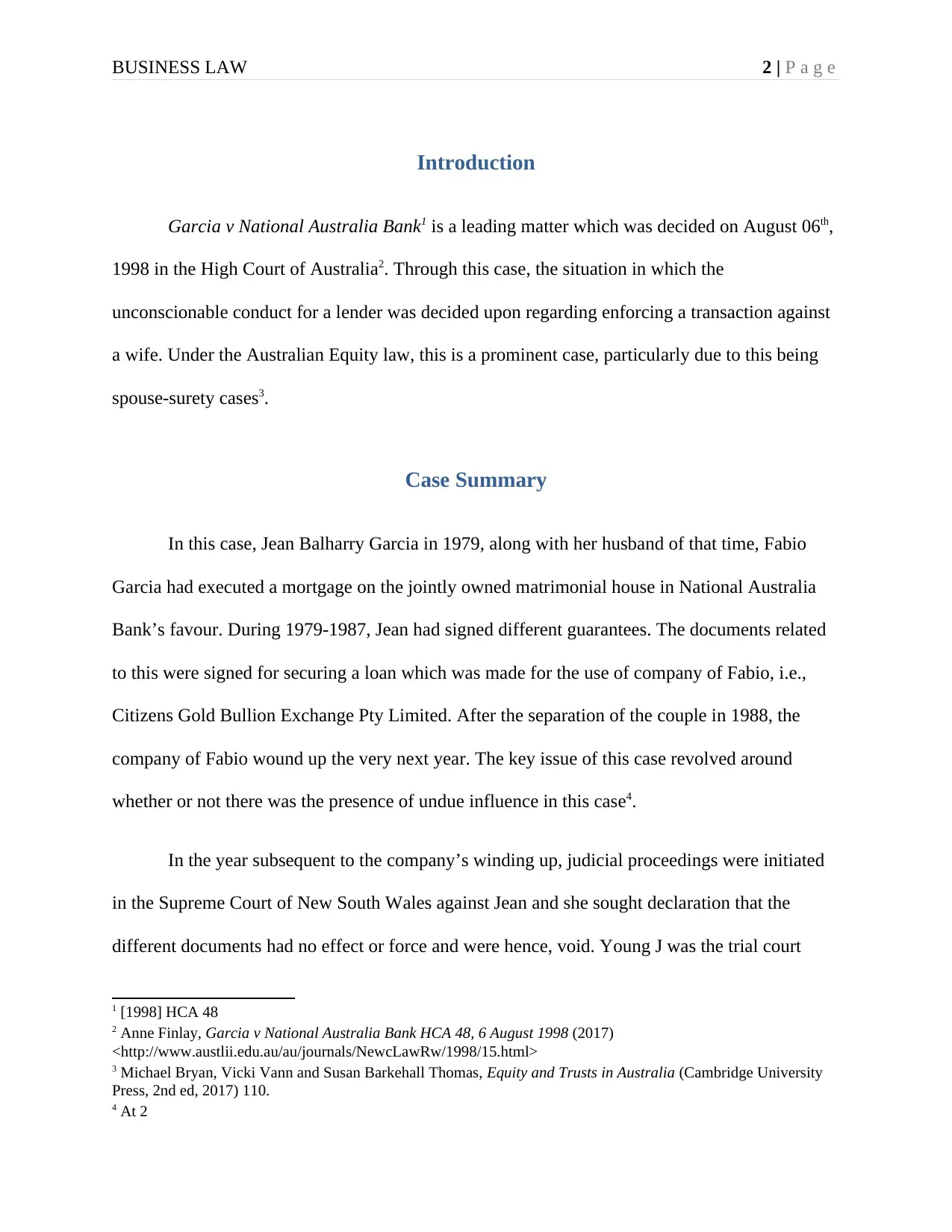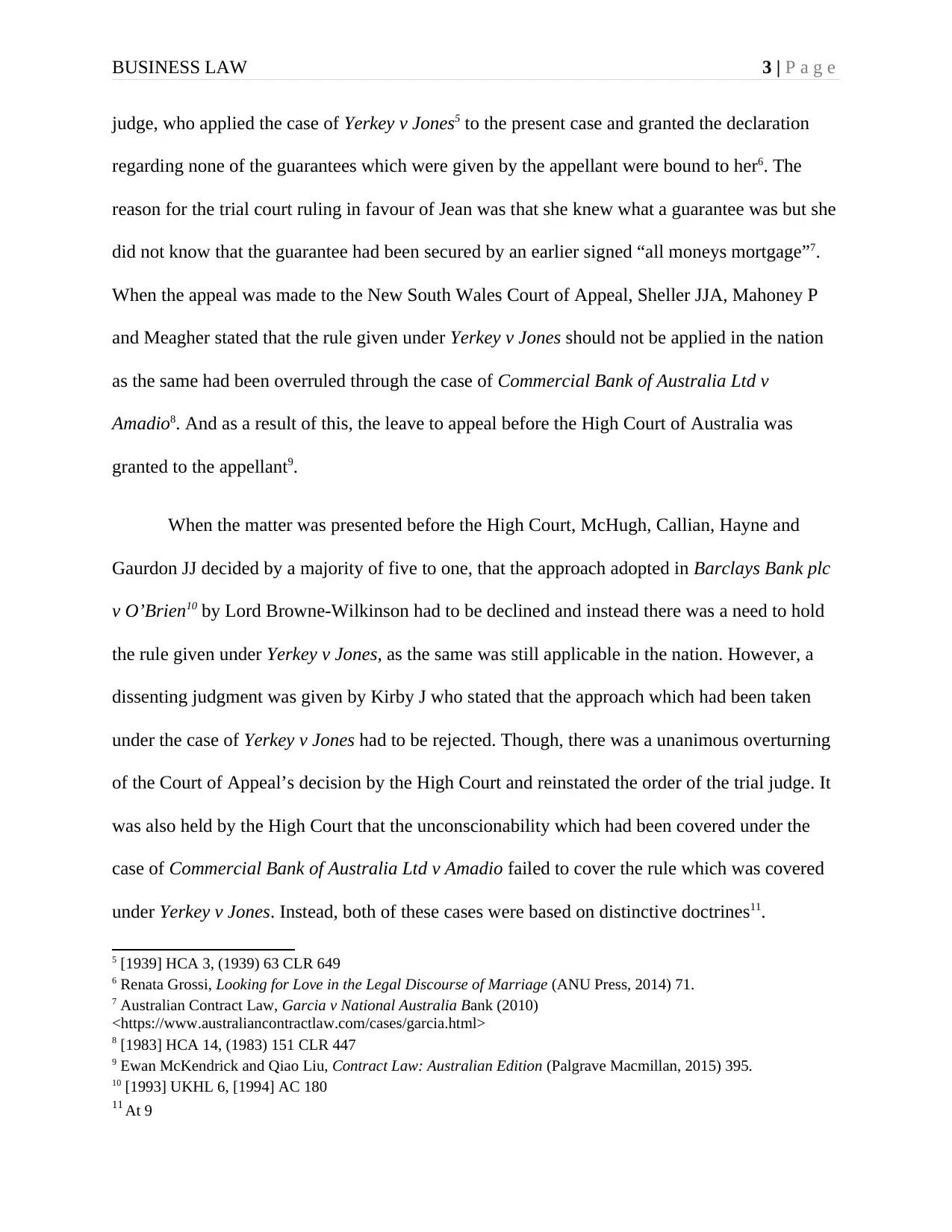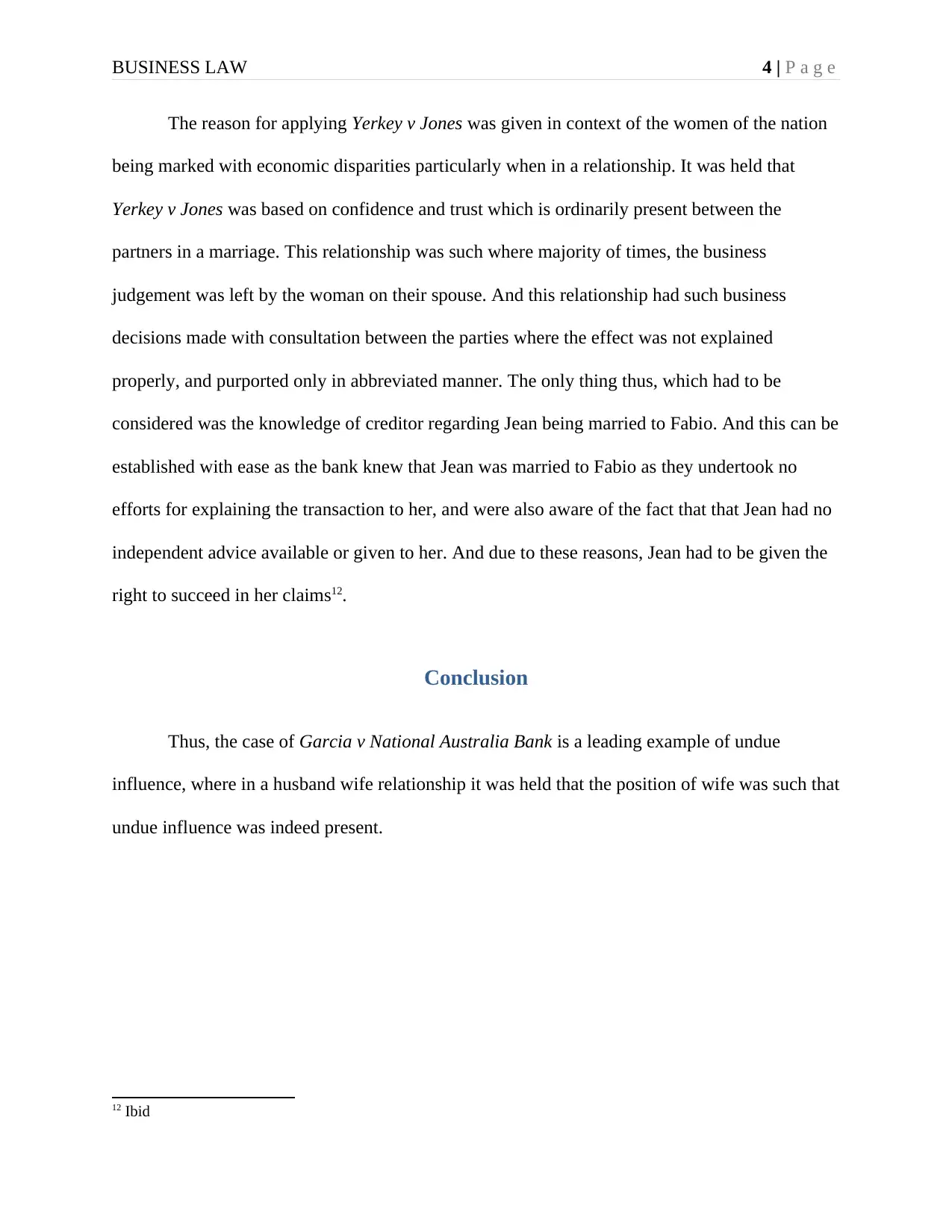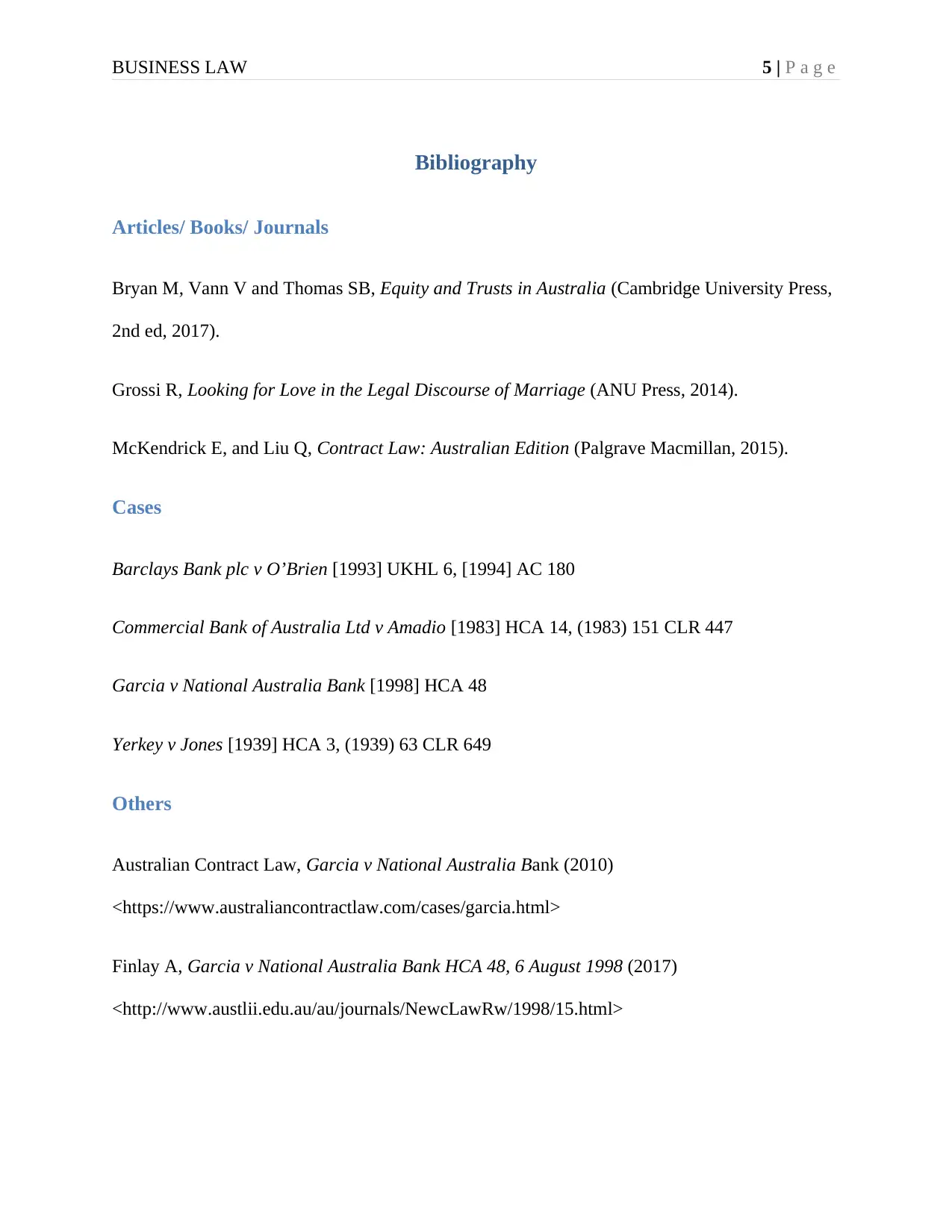Analysis of Garcia v National Australia Bank: Business Law Case Study
VerifiedAdded on 2020/05/04
|6
|1005
|33
Case Study
AI Summary
This case study provides a comprehensive analysis of Garcia v National Australia Bank [1998] HCA 48, a landmark case in Australian business law. The case revolves around the issue of unconscionable conduct by a lender in enforcing a transaction against a wife. The analysis covers the case summary, including the facts of the case, the legal issues, and the judgments of the courts, including the High Court of Australia. The case explores the application of undue influence, particularly in spouse-surety cases, and the relevance of the Yerkey v Jones and Commercial Bank of Australia Ltd v Amadio precedents. The document provides a detailed examination of the legal principles involved, the reasoning of the court, and the implications of the decision. The study concludes by highlighting the significance of the case in the context of Australian equity law, especially concerning the economic disparities between spouses. The document also includes a comprehensive bibliography of relevant articles, books, journals, and cases.

Paraphrase This Document
Need a fresh take? Get an instant paraphrase of this document with our AI Paraphraser

BUSINESS LAW 2 | P a g e
Introduction
Garcia v National Australia Bank1 is a leading matter which was decided on August 06th,
1998 in the High Court of Australia2. Through this case, the situation in which the
unconscionable conduct for a lender was decided upon regarding enforcing a transaction against
a wife. Under the Australian Equity law, this is a prominent case, particularly due to this being
spouse-surety cases3.
Case Summary
In this case, Jean Balharry Garcia in 1979, along with her husband of that time, Fabio
Garcia had executed a mortgage on the jointly owned matrimonial house in National Australia
Bank’s favour. During 1979-1987, Jean had signed different guarantees. The documents related
to this were signed for securing a loan which was made for the use of company of Fabio, i.e.,
Citizens Gold Bullion Exchange Pty Limited. After the separation of the couple in 1988, the
company of Fabio wound up the very next year. The key issue of this case revolved around
whether or not there was the presence of undue influence in this case4.
In the year subsequent to the company’s winding up, judicial proceedings were initiated
in the Supreme Court of New South Wales against Jean and she sought declaration that the
different documents had no effect or force and were hence, void. Young J was the trial court
1 [1998] HCA 48
2 Anne Finlay, Garcia v National Australia Bank HCA 48, 6 August 1998 (2017)
<http://www.austlii.edu.au/au/journals/NewcLawRw/1998/15.html>
3 Michael Bryan, Vicki Vann and Susan Barkehall Thomas, Equity and Trusts in Australia (Cambridge University
Press, 2nd ed, 2017) 110.
4 At 2
Introduction
Garcia v National Australia Bank1 is a leading matter which was decided on August 06th,
1998 in the High Court of Australia2. Through this case, the situation in which the
unconscionable conduct for a lender was decided upon regarding enforcing a transaction against
a wife. Under the Australian Equity law, this is a prominent case, particularly due to this being
spouse-surety cases3.
Case Summary
In this case, Jean Balharry Garcia in 1979, along with her husband of that time, Fabio
Garcia had executed a mortgage on the jointly owned matrimonial house in National Australia
Bank’s favour. During 1979-1987, Jean had signed different guarantees. The documents related
to this were signed for securing a loan which was made for the use of company of Fabio, i.e.,
Citizens Gold Bullion Exchange Pty Limited. After the separation of the couple in 1988, the
company of Fabio wound up the very next year. The key issue of this case revolved around
whether or not there was the presence of undue influence in this case4.
In the year subsequent to the company’s winding up, judicial proceedings were initiated
in the Supreme Court of New South Wales against Jean and she sought declaration that the
different documents had no effect or force and were hence, void. Young J was the trial court
1 [1998] HCA 48
2 Anne Finlay, Garcia v National Australia Bank HCA 48, 6 August 1998 (2017)
<http://www.austlii.edu.au/au/journals/NewcLawRw/1998/15.html>
3 Michael Bryan, Vicki Vann and Susan Barkehall Thomas, Equity and Trusts in Australia (Cambridge University
Press, 2nd ed, 2017) 110.
4 At 2

BUSINESS LAW 3 | P a g e
judge, who applied the case of Yerkey v Jones5 to the present case and granted the declaration
regarding none of the guarantees which were given by the appellant were bound to her6. The
reason for the trial court ruling in favour of Jean was that she knew what a guarantee was but she
did not know that the guarantee had been secured by an earlier signed “all moneys mortgage”7.
When the appeal was made to the New South Wales Court of Appeal, Sheller JJA, Mahoney P
and Meagher stated that the rule given under Yerkey v Jones should not be applied in the nation
as the same had been overruled through the case of Commercial Bank of Australia Ltd v
Amadio8. And as a result of this, the leave to appeal before the High Court of Australia was
granted to the appellant9.
When the matter was presented before the High Court, McHugh, Callian, Hayne and
Gaurdon JJ decided by a majority of five to one, that the approach adopted in Barclays Bank plc
v O’Brien10 by Lord Browne-Wilkinson had to be declined and instead there was a need to hold
the rule given under Yerkey v Jones, as the same was still applicable in the nation. However, a
dissenting judgment was given by Kirby J who stated that the approach which had been taken
under the case of Yerkey v Jones had to be rejected. Though, there was a unanimous overturning
of the Court of Appeal’s decision by the High Court and reinstated the order of the trial judge. It
was also held by the High Court that the unconscionability which had been covered under the
case of Commercial Bank of Australia Ltd v Amadio failed to cover the rule which was covered
under Yerkey v Jones. Instead, both of these cases were based on distinctive doctrines11.
5 [1939] HCA 3, (1939) 63 CLR 649
6 Renata Grossi, Looking for Love in the Legal Discourse of Marriage (ANU Press, 2014) 71.
7 Australian Contract Law, Garcia v National Australia Bank (2010)
<https://www.australiancontractlaw.com/cases/garcia.html>
8 [1983] HCA 14, (1983) 151 CLR 447
9 Ewan McKendrick and Qiao Liu, Contract Law: Australian Edition (Palgrave Macmillan, 2015) 395.
10 [1993] UKHL 6, [1994] AC 180
11 At 9
judge, who applied the case of Yerkey v Jones5 to the present case and granted the declaration
regarding none of the guarantees which were given by the appellant were bound to her6. The
reason for the trial court ruling in favour of Jean was that she knew what a guarantee was but she
did not know that the guarantee had been secured by an earlier signed “all moneys mortgage”7.
When the appeal was made to the New South Wales Court of Appeal, Sheller JJA, Mahoney P
and Meagher stated that the rule given under Yerkey v Jones should not be applied in the nation
as the same had been overruled through the case of Commercial Bank of Australia Ltd v
Amadio8. And as a result of this, the leave to appeal before the High Court of Australia was
granted to the appellant9.
When the matter was presented before the High Court, McHugh, Callian, Hayne and
Gaurdon JJ decided by a majority of five to one, that the approach adopted in Barclays Bank plc
v O’Brien10 by Lord Browne-Wilkinson had to be declined and instead there was a need to hold
the rule given under Yerkey v Jones, as the same was still applicable in the nation. However, a
dissenting judgment was given by Kirby J who stated that the approach which had been taken
under the case of Yerkey v Jones had to be rejected. Though, there was a unanimous overturning
of the Court of Appeal’s decision by the High Court and reinstated the order of the trial judge. It
was also held by the High Court that the unconscionability which had been covered under the
case of Commercial Bank of Australia Ltd v Amadio failed to cover the rule which was covered
under Yerkey v Jones. Instead, both of these cases were based on distinctive doctrines11.
5 [1939] HCA 3, (1939) 63 CLR 649
6 Renata Grossi, Looking for Love in the Legal Discourse of Marriage (ANU Press, 2014) 71.
7 Australian Contract Law, Garcia v National Australia Bank (2010)
<https://www.australiancontractlaw.com/cases/garcia.html>
8 [1983] HCA 14, (1983) 151 CLR 447
9 Ewan McKendrick and Qiao Liu, Contract Law: Australian Edition (Palgrave Macmillan, 2015) 395.
10 [1993] UKHL 6, [1994] AC 180
11 At 9
⊘ This is a preview!⊘
Do you want full access?
Subscribe today to unlock all pages.

Trusted by 1+ million students worldwide

BUSINESS LAW 4 | P a g e
The reason for applying Yerkey v Jones was given in context of the women of the nation
being marked with economic disparities particularly when in a relationship. It was held that
Yerkey v Jones was based on confidence and trust which is ordinarily present between the
partners in a marriage. This relationship was such where majority of times, the business
judgement was left by the woman on their spouse. And this relationship had such business
decisions made with consultation between the parties where the effect was not explained
properly, and purported only in abbreviated manner. The only thing thus, which had to be
considered was the knowledge of creditor regarding Jean being married to Fabio. And this can be
established with ease as the bank knew that Jean was married to Fabio as they undertook no
efforts for explaining the transaction to her, and were also aware of the fact that that Jean had no
independent advice available or given to her. And due to these reasons, Jean had to be given the
right to succeed in her claims12.
Conclusion
Thus, the case of Garcia v National Australia Bank is a leading example of undue
influence, where in a husband wife relationship it was held that the position of wife was such that
undue influence was indeed present.
12 Ibid
The reason for applying Yerkey v Jones was given in context of the women of the nation
being marked with economic disparities particularly when in a relationship. It was held that
Yerkey v Jones was based on confidence and trust which is ordinarily present between the
partners in a marriage. This relationship was such where majority of times, the business
judgement was left by the woman on their spouse. And this relationship had such business
decisions made with consultation between the parties where the effect was not explained
properly, and purported only in abbreviated manner. The only thing thus, which had to be
considered was the knowledge of creditor regarding Jean being married to Fabio. And this can be
established with ease as the bank knew that Jean was married to Fabio as they undertook no
efforts for explaining the transaction to her, and were also aware of the fact that that Jean had no
independent advice available or given to her. And due to these reasons, Jean had to be given the
right to succeed in her claims12.
Conclusion
Thus, the case of Garcia v National Australia Bank is a leading example of undue
influence, where in a husband wife relationship it was held that the position of wife was such that
undue influence was indeed present.
12 Ibid
Paraphrase This Document
Need a fresh take? Get an instant paraphrase of this document with our AI Paraphraser

BUSINESS LAW 5 | P a g e
Bibliography
Articles/ Books/ Journals
Bryan M, Vann V and Thomas SB, Equity and Trusts in Australia (Cambridge University Press,
2nd ed, 2017).
Grossi R, Looking for Love in the Legal Discourse of Marriage (ANU Press, 2014).
McKendrick E, and Liu Q, Contract Law: Australian Edition (Palgrave Macmillan, 2015).
Cases
Barclays Bank plc v O’Brien [1993] UKHL 6, [1994] AC 180
Commercial Bank of Australia Ltd v Amadio [1983] HCA 14, (1983) 151 CLR 447
Garcia v National Australia Bank [1998] HCA 48
Yerkey v Jones [1939] HCA 3, (1939) 63 CLR 649
Others
Australian Contract Law, Garcia v National Australia Bank (2010)
<https://www.australiancontractlaw.com/cases/garcia.html>
Finlay A, Garcia v National Australia Bank HCA 48, 6 August 1998 (2017)
<http://www.austlii.edu.au/au/journals/NewcLawRw/1998/15.html>
Bibliography
Articles/ Books/ Journals
Bryan M, Vann V and Thomas SB, Equity and Trusts in Australia (Cambridge University Press,
2nd ed, 2017).
Grossi R, Looking for Love in the Legal Discourse of Marriage (ANU Press, 2014).
McKendrick E, and Liu Q, Contract Law: Australian Edition (Palgrave Macmillan, 2015).
Cases
Barclays Bank plc v O’Brien [1993] UKHL 6, [1994] AC 180
Commercial Bank of Australia Ltd v Amadio [1983] HCA 14, (1983) 151 CLR 447
Garcia v National Australia Bank [1998] HCA 48
Yerkey v Jones [1939] HCA 3, (1939) 63 CLR 649
Others
Australian Contract Law, Garcia v National Australia Bank (2010)
<https://www.australiancontractlaw.com/cases/garcia.html>
Finlay A, Garcia v National Australia Bank HCA 48, 6 August 1998 (2017)
<http://www.austlii.edu.au/au/journals/NewcLawRw/1998/15.html>

BUSINESS LAW 6 | P a g e
⊘ This is a preview!⊘
Do you want full access?
Subscribe today to unlock all pages.

Trusted by 1+ million students worldwide
1 out of 6
Related Documents
Your All-in-One AI-Powered Toolkit for Academic Success.
+13062052269
info@desklib.com
Available 24*7 on WhatsApp / Email
![[object Object]](/_next/static/media/star-bottom.7253800d.svg)
Unlock your academic potential
Copyright © 2020–2025 A2Z Services. All Rights Reserved. Developed and managed by ZUCOL.




